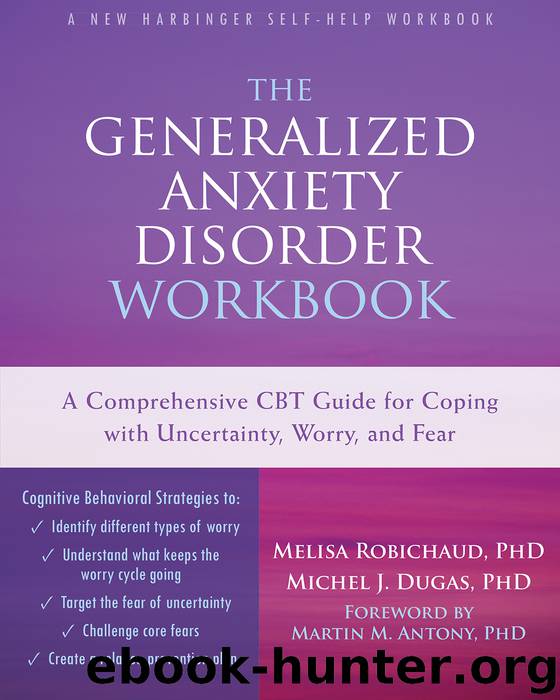The generalized anxiety disorder workbook by Melisa Robichaud & Michel J. Dugas

Author:Melisa Robichaud & Michel J. Dugas
Language: eng
Format: epub
Publisher: New Harbinger Publications, Inc.
Published: 2015-11-29T16:00:00+00:00
Changing the Way You Think
Changing what you believe or how you think can be quite tricky. Many of our clients come to CBT with the assumption that their thinking will be “reprogrammed” or that they’ll learn to “think positively.” This isn’t the case. You change the way you think about something in the same way you might get others to change their mind on an issue: you make a compelling case that they can truly believe. For example, say you have a friend who lives in the city, and you want her to believe that living in the country is a better choice for her. You won’t change her mind just by asking her to change it. You might tell her about the benefits of living in the country: the peace and quiet, the slower pace of life, and the clean air. You might also tell her that living in the city is more expensive, that it’s noisy, and there’s more pollution; or you might encourage her to take a vacation in the country to experience what it’s like. If your arguments and the evidence you gather are compelling, your friend might change her belief about the value of living in the country.
We use this same approach for changing beliefs about uncertainty in day-to-day situations. If you want to think differently about uncertainty, you can’t simply tell yourself to do so. Rather, you’ll need to gather evidence that will allow you to see whether your current beliefs about uncertainty provide an accurate representation of situations that lead to worry.
One of the best ways to gather evidence for or against a belief is through actual experience. For example, if you avoid going to the dentist because you think it will be very painful, a good way to find out whether your belief is accurate is to actually go to the dentist. By doing so, you’ll be in a good position to determine whether dental work is as painful as you’d expected. In this way, by changing your behavior, you put yourself in a position to obtain factual information about the situation. This information might lead you to change your belief.
With this in mind, you can also obtain evidence for or against your beliefs about uncertainty in unpredictable, novel, and ambiguous situations by changing your behavior. Specifically, by decreasing your safety behaviors, you can find out whether uncertainty is as negative and threatening as you think it is.
Download
This site does not store any files on its server. We only index and link to content provided by other sites. Please contact the content providers to delete copyright contents if any and email us, we'll remove relevant links or contents immediately.
Rewire Your Anxious Brain by Catherine M. Pittman(17621)
Talking to Strangers by Malcolm Gladwell(11960)
The Art of Thinking Clearly by Rolf Dobelli(8902)
Mindhunter: Inside the FBI's Elite Serial Crime Unit by John E. Douglas & Mark Olshaker(7878)
Becoming Supernatural by Dr. Joe Dispenza(7144)
Change Your Questions, Change Your Life by Marilee Adams(6687)
The Road Less Traveled by M. Scott Peck(6672)
Nudge - Improving Decisions about Health, Wealth, and Happiness by Thaler Sunstein(6669)
The Lost Art of Listening by Michael P. Nichols(6514)
Enlightenment Now: The Case for Reason, Science, Humanism, and Progress by Steven Pinker(6436)
Win Bigly by Scott Adams(6345)
Mastermind: How to Think Like Sherlock Holmes by Maria Konnikova(6280)
The Way of Zen by Alan W. Watts(5830)
Daring Greatly by Brene Brown(5680)
Big Magic: Creative Living Beyond Fear by Elizabeth Gilbert(4765)
Grit by Angela Duckworth(4761)
Men In Love by Nancy Friday(4369)
Flow by Mihaly Csikszentmihalyi(4081)
The Four Tendencies by Gretchen Rubin(4044)
